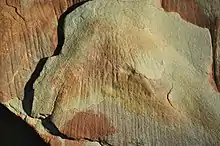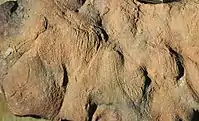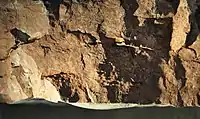Arumberia
Arumberia is an enigmatic fossil from the Ediacaran period[1] originally described from the Arumbera Sandstone, Northern Territory, Australia[2] but also found in the Urals,[3] East Siberia,[4] England and Wales,[5] Northern France,[5] the Avalon Peninsula[5] and India.[6] Several morphologically distinct species are recognized.[3][7]
| Arumberia Temporal range: Late Ediacaran | |
|---|---|
 | |
| Holotype specimen of Arumberia banksi, a convex hyporelief on the base of a sandstone bed from the Ediacaran Arumbera Sandstone near Alice Springs, Australia | |
| Scientific classification | |
| Kingdom: | |
| Genus: | Arumberia Glaessner et Walter, 1975 |
| Type species | |
| Arumberia banksi Glaessner et Walter, 1975 | |
| Species | |
| |
Description
Initially discovered by Glaessner and Walter (1975), Arumberia was described as a problematic cupped-body fossil of an Ediacaran soft-bodied organism characterized by hollow compressible ribbed bodies composed of flexible tissue. Brasier (1979) deemed it a pseudofossil arising from turbid water flow in shallow marine or deltaic environments, due in part to physical and morphological similarities to flume-induced structures previously observed by Dzulynski and Walton (1965). Arumberia appears as a poorly-delimited series of fine parallel grooves arising from a single region or point. Arumberia banksii consists of an array of straight to gently curved parallel to subparallel ridges (rugae) about 1 – 3 mm wide and separated by flat to gently concave furrows of 1 – 7 mm in width. Relief from ridge top to furrow bottom is less than 1 mm. Ridge ranges in length from 1.5 cm to 14.5 cm. Generally the ridges are parallel, but they also bifurcate. Ridges are developed on plane and rippled surfaces.[6]
List of Species
There are four species of Arumberia that have been formally recognized. Arumberia banksi has thin siliciclastic biolaminites known as rugose structures[3] including those with subparallel or fanning-out series of rugae (Arumberia banksi s.str.) and sub-parallel series of branching rugae (Arumberia vindhyanensis).[3] The Arumberia multykensis variety is found in greenish gray siltstones as series of near-parallel ridges with positive hyporelief up to 1 mm wide and 0.5 mm high, with 10 mm spacing between the ridges[3] while A. usavaensis occurs as a series of near parallel ridges on the wavy surfaces on linguoid ripple marks which stretch along the paleoflow direction and flatten out as microterraces on the leeward side of the ripples.[3] Arumberia usavensis is found on both upper and lower surfaces of sandstone beds as well as inside sandstones and siltstones.[3] Arumberia beckeri and Arumberia ollii are morphologically distinct from A. banksi[3] and are filamentous and ribbon-shaped compressed macrofossils which host authigenic clay minerals and are most likely unrelated to Arumberia.[7]


Locations
Arumberia was first described in Neoproterozoic red sandstones of the lower Arumbera sandstone formation of the Amadeus Basin in Northern Territory, Australia.[2] It has since been found in Argentina, Newfoundland, England, Wales, northeastern Europe, the eastern Sayan Mountains in Russia, Central India, and Rajasthan.[5][6][3][7][8][9] In addition, Arumberia has been reported from lower Palaeozoic strata in Brittany, France[5][9] and from the Upper Ediacaran Cerro Negro Formation in Argentina.[8]
Identity
The identity of Arumberia is controversial. Arumberia has been originally interpreted as a 5–20 cm high cup-like organism, apparently composed of flexible tissue, attached to the sea bottom by a blunt apex[2] or, later, as a colonial organism made of flexible, thin-walled tubes tightly joined through their length.[5] Affinities with Ernietta, Conostichus, Pteridinium, Palaeoplatoda, Phyllozoon and Bergaueria and Chuaria have been conjectured.[5] Spheroidal objects found along with Arumberia have also been interpreted as "dispersable stage" of Arumberia itself.[5] Arumberia has been interpreted as a microbial mat morphotype developed in response to environmental perturbations in terminal Ediacaran shallow marine basins[7]
Conversely, a non biological interpretation has been put forward[1][10] Past experiments reproduced Arumberia-like traces from flume experiments[11] and from the flux of water around small objects.[12] The absence of Arumberia-like structures after the Ediacaran period could be due to the unique properties of the microbial mat that covered the sea floor at the period.[1] However, there is still debate, with recent analysis of Urals' Arumberia-like structures leaning towards a biological interpretation as an organism adapted to shallow water environments.[3] The rugae of Arumberia are considered to form from exclusively biological processes as observed in modern microbial mats[7] and not from sediment desiccation, cracking or other abiotic processes. Fine wisps of organic material have been observed in thin section of Arumberia cut perpendicular to bedding planes,[9] further suggesting that Arumberia was a living organism.
Recent work describes Arumberia as the fossilized remains of highly organized shallow marine microbial colonies;[3][7][13] a microbially-induced sedimentary structure (MISS),;[9][14][15][6][16] a series of slide marks underneath tough biomats that were exposed to tractional currents carrying sediment,[17] or a biopolymer-bearing lichenized fungi.[18][19][20][21] As such, Arumberia structures remain an enigmatic Ediacaran fossil.
Taphonomy
Facies
The Ediacaran facies where Arumberia has been found are interpreted as terrigenous sedimentary rocks in shallow marine[22][23][24] or fluviolacustrine (intertidal or delta plain) settings[7] that may have been affected by desiccation and salinity.[25] However, an alternative interpretation of the Ediacaran facies where Arumberia is found is that they were coastal gyspiferous paleosols of intertidal to supratidal settings.[19][20][21] Terminal Ediacaran (560 Ma) facies in Baltica dominantly contain biomarkers (hopane and sterane ratios) characteristic of bacterially-dominated communities in shallow marine oligotrophic settings.[24] These values reflect a high ratio of bacterial to eukaryotic biomass and suggest these ecosystems were nutrient-limited and dominated by bacterial communities, which may have imposed growth constraints and evolutionary modifications to Ediacaran organisms like Arumberia.
Burial Compaction and Diagenesis
The original interpretation of Arumberia as a conical or cup-shaped depression structure is contrary to modern interpretations of Arumberia as a bulge or impression.[26] Extensive burial from overburden typical in areas where Arumberia is found would greatly compact any bulge or depression of a typical soft-bodied marine metazoan; however, it has been suggested that diagenic silicification, ferrugination or pyritization can provide critical fossil rigidity during burial [8][27][26] which supports the soft-body marine metazoan description of Arumberia. The presence of pyrite may impart significant resistance to burial compaction[14][26][28][29] in Arumberia, but to date no study has demonstrated a thick pyritic film of sufficient strength to withstand burial compaction above an unpyritized Ediacaran fossil,[29] which is thought to be a requirement for the preservational models that involve the pyritization of soft-body metazoans like Arumberia.
Analysis of thin sections of Arumberia show remarkable resistance to compaction, which may have been due to the presence of a pyrite sole-veneer.[26] The diagenetic oxidation of pyrite to hematite can remove all traces of the pyrite sole-veneer,[26] so it is difficult to determine the true influence of pyritization on burial compaction in Arumberia. Alternatively, the remarkable resistance to burial compaction may be due to the presence of a resistant biopolymer like chitin which is typical in marine and terrestrial lichens alike[18][21] Exactly how the fossils are preserved remains controversial, and more research into the taphonomy of Arumberia and other Ediacarans is needed.[27]
References
- McIlroy, D.; Walter, M. (1997). "A reconsideration of the biogenicity of Arumberia banksi Glaessner & Walter". Alcheringa: An Australasian Journal of Palaeontology. 21: 79–80. doi:10.1080/03115519708619187.
- Glaessner, M. F.; Walter, M. R. (1975). "New Precambrian fossils from the Arumbera Sandstone, Northern Territory, Australia". Alcheringa: An Australasian Journal of Palaeontology. 1: 59–69. doi:10.1080/03115517508619480.
- Kolesnikov, A. V.; Grazhdankin, D. V.; Maslov, A. V. (2012). "Arumberia-type structures in the Upper Vendian of the Urals". Doklady Earth Sciences. 447 (1): 1233–1239. Bibcode:2012DokES.447.1233K. doi:10.1134/S1028334X12110013. S2CID 140695807. Retrieved 27 January 2013.
- Bogolepova, O. K.; Gubanov, A. P.; Howard, J. P.; Gómez-Pérez, M. (2010). "Arumberia and other microbial mats from the Neoproterozoic-Cambrian strata of East Siberia". Geophysical Research Abstracts. 12: 3143. Bibcode:2010EGUGA..12.3143B.
- Bland, B. H. (1984). "Arumberia Glaessner & Walter, a review of its potential for correlation in the region of the Precambrian–Cambrian boundary". Geological Magazine. 121 (6): 625–633. Bibcode:1984GeoM..121..625B. doi:10.1017/S0016756800030776. S2CID 128492261.
- Kumar, S.; Pandey, S. K. (December 2009). "Note on the occurrence of Arumberia Banksi and associated fossils from the Jodhpur Sandstone, Marwar Supergroup, western Rajasthan" (PDF). Journal of the Paleontological Society of India. 54 (2): 171–178.
- Kolesnikov, A. V.; Danelian, T.; Gommeaux, M.; Maslov, A. V.; Grazhdankin, D. V. (2017). "Arumberiamorph structure in modern microbial mats: Implications for Ediacaran palaeobiology". Bulletin de la Société Géologique de France. 188 (1–2): 5. doi:10.1051/bsgf/2017006.
- Arrouy, M. J.; Warren, L. V.; Quaglio, F.; Poiré, D. G.; Simões, M. G.; Rosa, M. B.; Peral, L. E. G. (2016). "Ediacaran discs from South America: Probable soft-bodied macrofossils unlock the paleogeography of the Clymene Ocean". Scientific Reports. 6: 30590. Bibcode:2016NatSR...630590A. doi:10.1038/srep30590. PMC 4962044. PMID 27460966.
- Davies, N. S.; Liu, A. G.; Gibling, M. R.; Miller, R. F. (2016). "Resolving MISS conceptions and misconceptions: A geological approach to sedimentary surface textures generated by microbial and abiotic processes". Earth-Science Reviews. 154: 210–246. Bibcode:2016ESRv..154..210D. doi:10.1016/j.earscirev.2016.01.005. hdl:1983/bd67cb45-b022-4db0-be3d-b2977d2b81ab. S2CID 56345018.
- Brasier, M. D. (1979). "The Cambrian radiation event". The origin of major invertebrate groups. London, New York: Academic Press. pp. 103–159.
- Dzulynski, S.; Walton, E. K. (1965). Sedimentary Features of Flysch and Greywackes. Amsterdam: Elsevier. p. 282. ISBN 9780080869179.
- Allen, J. R. L. (1982). Sedimentary structures, their character and physical basis. Part II. Amsterdam: Elsevier. pp. 1–676.
- Kolesnikov, A. V.; Marusin, V. V.; Nagovitsin, K. E.; Maslov, A. V.; Grazhdankin, D. V. (2015). "Ediacaran biota in the aftermath of the Kotlinian Crisis: Asha Group of the South Urals". Precambrian Research. 263: 59–78. Bibcode:2015PreR..263...59K. doi:10.1016/j.precamres.2015.03.011.
- Gehling, J. G. (1999). "Microbial Mats in Terminal Proterozoic Siliciclastics: Ediacaran Death Masks". PALAIOS. 14 (1): 40–57. Bibcode:1999Palai..14...40G. doi:10.2307/3515360. JSTOR 3515360.
- Kumar, S.; Pandey, S. K. (2008). "Arumberia banksi and associated fossils from the Neoproterozoic Maihar Sandstone, Vindhyan Supergroup, Central India". Journal of the Palaeontological Society of India. 53 (1): 83–97.
- Kumar, S.; Ahmad, S. (2014). "Microbially induced sedimentary structures (MISS) from the Ediacaran Jodhpur Sandstone, Marwar Supergroup, western Rajasthan". Journal of Asian Earth Sciences. 91: 352–361. Bibcode:2014JAESc..91..352K. doi:10.1016/j.jseaes.2014.01.009.
- Seilacher, A. (2007). – Trace fossil analysis. – Springer-Verlag (Berlin).
- Retallack, G. J. (1994). "Were the Ediacaran Fossils Lichens?" (PDF). Paleobiology. 20 (4): 523–544. Bibcode:1994Pbio...20..523R. doi:10.1017/S0094837300012975. JSTOR 2401233. S2CID 129180481.
- Retallack, G. J. (2012). "Criteria for Distinguishing Microbial Mats and Earths". In Nora Noffke; Henry Chafetz (eds.). Microbial Mats in Silicilastic Depositional Systems Through Time. SEPM Special Publication. Vol. 101. pp. 139–152. doi:10.2110/sepmsp.101.139. ISBN 978-1-56576-314-2.
- Retallack, G. J. (2012). "Were Ediacaran siliciclastics of South Australia coastal or deep marine?". Sedimentology. 59 (4): 1208–1236. Bibcode:2012Sedim..59.1208R. doi:10.1111/j.1365-3091.2011.01302.x. S2CID 129547681.
- Retallack, G. J. (2013). "Ediacaran life on land". Nature. 493 (7430): 89–92. Bibcode:2013Natur.493...89R. doi:10.1038/nature11777. PMID 23235827. S2CID 205232092.
- Gehling, J. G. (2000). "Environmental interpretation and a sequence stratigraphic framework for the terminal Proterozoic Ediacara Member within the Rawnsley Quartzite, South Australia". Precambrian Research. 100 (1–3): 65–95. Bibcode:2000PreR..100...65G. doi:10.1016/S0301-9268(99)00069-8.
- Gehling, J. G.; Droser, M. L. (2012). "Ediacaran stratigraphy and the biota of the Adelaide Geosyncline, South Australia". Episodes. 35: 236–246. doi:10.18814/epiiugs/2012/v35i1/023. S2CID 129497585.
- Pehr, K.; Love, G. D.; Kuznetsov, A.; Podkovyrov, V.; Junium, C. K.; Shumlyanskyy, L.; Sokur, T.; Bekker, A. (2018). "Ediacara biota flourished in oligotrophic and bacterially dominated marine environments across Baltica". Nature Communications. 9 (1): 1807. Bibcode:2018NatCo...9.1807P. doi:10.1038/s41467-018-04195-8. PMC 5935690. PMID 29728614.
- Danelian, T.; Jolivet, M.; Ionov, D. (2017). "An introduction to the special issue of the BSGF". Bulletin de la Société Géologique de France. 188 (1–2): E1. doi:10.1051/bsgf/2017001.
- Mapstone, N. B.; McIlroy, D. (2006). "Ediacaran fossil preservation: Taphonomy and diagenesis of a discoid biota from the Amadeus Basin, central Australia". Precambrian Research. 149 (3–4): 126–148. Bibcode:2006PreR..149..126M. doi:10.1016/j.precamres.2006.05.007.
- Tarhan, L. G.; Hood, A. V. S.; Droser, M. L.; Gehling, J. G.; Briggs, D. E. G. (2016). "Exceptional preservation of soft-bodied Ediacara Biota promoted by silica-rich oceans". Geology. 44 (11): 951–954. Bibcode:2016Geo....44..951T. doi:10.1130/G38542.1.
- Dzik, J.; Ivantsov, A. Yu. (2002). "Internal anatomy of a new Precambrian dickinsoniid dipleurozoan from northern Russia" (PDF). Neues Jahrbuch für Geologie und Paläontologie - Monatshefte. 2002 (7): 385–396. doi:10.1127/njgpm/2002/2002/385.
- Liu, A. G. (2016). "Framboidal Pyrite Shroud Confirms the 'Death Mask' Model for Moldic Preservation of Ediacaran Soft-Bodied Organisms". PALAIOS. 31 (5): 259–274. Bibcode:2016Palai..31..259L. doi:10.2110/palo.2015.095. hdl:1983/535d288a-68ee-4481-8553-6b7d2e45dacb. S2CID 132601490.